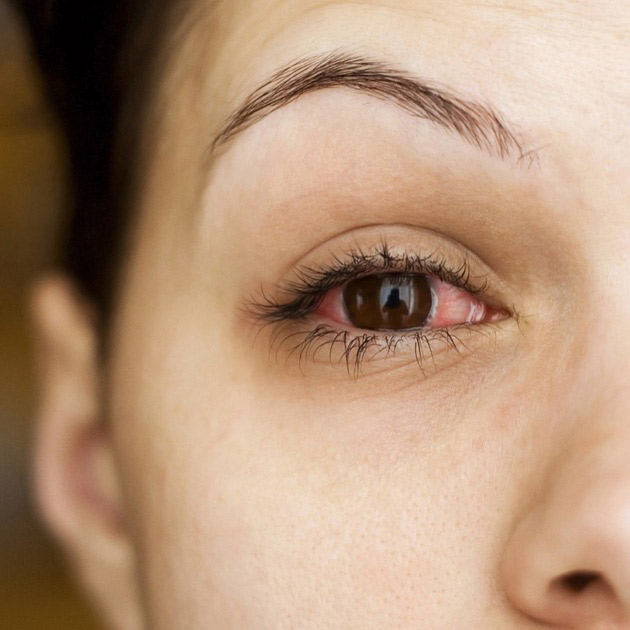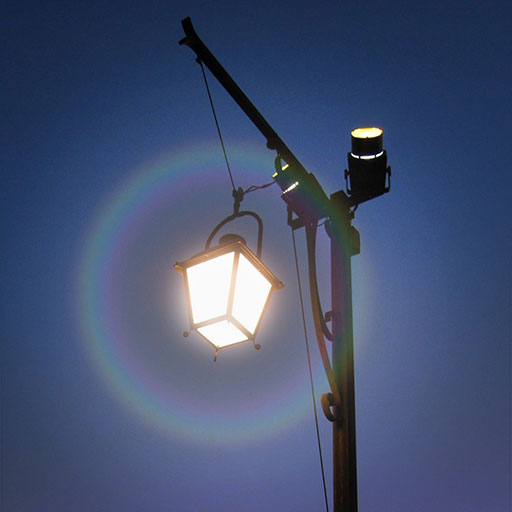This is an acute condition. Fluid is continually produced inside the front part of the eye, and drains out of the normal eye. This fluid, called aqueous humor, is unrelated to the tears, which are only on the outside of the eye. Higher pressure occurs when there is an imbalance in the production and drainage of fluid in the eye. If the channels within the eye that normally drain the fluid from inside the eye are blocked, the pressure within the eye will rise suddenly. In this case, more fluid is continually being produced but cannot be drained because of the blocked drainage channels. This results in too much fluid inside the front chamber of the eye, thus raising the intraocular pressure. This usually occurs when it is dark. Acute angle-closure glaucoma occurs suddenly.
Typical symptoms include:
- Eye pain.
- Headaches.
- Rainbow halos around lights.
- Dilated pupils.
- Vision loss.
- Red eyes.
- Excessive tearing.
- Nausea and vomiting.
Farsighted individuals are at a slightly higher risk of developing closed angle glaucoma because they typically have a flatter cornea which narrows the area where the fluid is drained.
These signs may last for hours or until the eye pressure is reduced. With each narrow-angle glaucoma attack, part of your peripheral vision may also be lost. Acute angle-closure glaucoma is a medical emergency. If the high eye pressure is not reduced within hours, it can cause permanent vision loss. Anyone who experiences these symptoms should contact their optometrist, or ophthalmologist immediately.
Your ophthalmologist might choose to do a procedure known as a Trabeculectomy, where they remove a small piece of the iris (usually at the top which is typically covered by the upper eyelid). This procedure can prevent the blockage from reoccurring.
Signs and Symptoms
If you have the acute form of the condition, you will likely experience a sudden onset. You won’t be able to ignore them.
Typical symptoms include:
- Eye pain.
- Severe headaches.
- Rainbow halos around lights.
- Dilated pupils.
- Very blurry or Hazy vision.
- Pupils of different sizes.
- Red eyes.
- Excessive tearing.
- Nausea and vomiting.
Causes and Risks
With angle-closure glaucoma, the iris is not as wide and open as it should be. The outer edge of the iris bunches up over the drainage canals, when the pupil enlarges too much or too quickly. This can happen when entering a dark room.
Several anatomic abnormalities lead to anterior chamber crowding and predispose individuals to AACG (acute Angle Closure Glaucoma). These include shallower anterior chambers, thinner ciliary bodies, a thinner iris, anteriorly situated thicker lens, and a shorter axial eye length. Recent studies have suggested that increased iris thickness and cross-sectional area are associated with increased risk. Of the many predisposing anatomical variations, a narrow angle has the most devastating consequences.
In the traditional model of AACG, the eye's natural response of dilation to environmental or chemical stimuli results in a pathologic iris-lens apposition. The apposition and contact between the lens and the iris is called pupillary block. Furthermore, pupillary block describes a state in which the forward-most surface of the lens is anterior to the plane of the iris insertion into the ciliary body. As a result, aqueous flow from the posterior chamber to the anterior chamber is obstructed or altogether blocked. When pupillary block occurs in conjunction with the iris, the increasing pressure in the posterior chamber causes the pliable iris, particularly the peripheral region, to bow forward in a process termed iris bombé. Iris bombé further closes the already narrow angle and compromises aqueous drainage, thus increasing IOP.
Your risk for closed-angle glaucoma is greater if you:
- are older than 40 years of age, especially if you are between 60 and 70 years old.
- are farsighted.
- are female.
- have a brother, sister, or parent with the disease.
- are of Southeast Asian or Alaska Native origin.
Stats and Incidence
In the United States, fewer than 10% of glaucoma cases are due to angle-closure glaucoma. In Asia, angle-closure glaucoma is more common than open-angle glaucoma. Certain races (for example, Asians and Eskimos) have narrow angles and, thus, are more likely to develop angle-closure glaucoma than Caucasians. In Caucasians, angle-closure glaucoma is three times higher in women than in men. In Africans, men and women are affected equally. AACG occurs in 1 of 1000 whites, about 1 in 100 Asians, and as many as 2-4 of 100 Eskimos.
Outcome after AACG is dependent on duration from onset to treatment, underlying ocular disease, and ethnicity. The degree of IOP elevation has been shown to have less impact on future visual acuity. Studies report that as many as two thirds of individuals with AACG had no visual field loss. However, Asians appear to be more refractory to the initial medical management, and, even after definitive treatment, they experience a progressive increase in IOP and deterioration in visual acuity.
AACG predominately affects females because of their shallower anterior chamber.
If one of your close relatives (mother, father, sister or brother) has had AACG, you have an increased risk of developing it. This is because you may have inherited an eye shape which makes AACG more likely. If you have a positive family history like this you should speak to an optician regarding when, and how often, you should have eye checks.
Treatment
Treatment of angle-closure glaucoma usually involves drugs, and or either laser or conventional surgery to remove a small portion of the bunched-up outer edge of the iris. Surgery helps unblock the drainage canals so that the extra fluid can drain. If you have angle-closure glaucoma in one eye, doctors may go ahead and treat the other eye as a safety measure.
Typical drugs that are used to treat AACG are:
- Acetazolamide, which reduces the fluid in your eye.
- Beta blockers, which lower the amount of fluid your eye produces.
- Steroids, which reduce inflammation.
- Painkillers (as a comfort measure).
- Drugs to treat nausea and vomiting.
- Pilocarpine, which opens the angle between your iris and cornea.
Once the pressure in your eye has decreased, you will need further treatment to prevent the pressure from rising again.
There are two surgeries used to address closed-angle glaucoma:
- Peripheral Iridotomy. This is a laser treatment that creates two tiny drainage holes in your iris. It is used to treat both acute and chronic closed-angle glaucoma.
- Surgical Iridectomy. In this less-common treatment, a surgeon makes a small triangular opening in your iris.
In general, surgery for angle-closure glaucoma is successful and long lasting. Regular checkups are still important though, because a chronic form of glaucoma could still occur.


